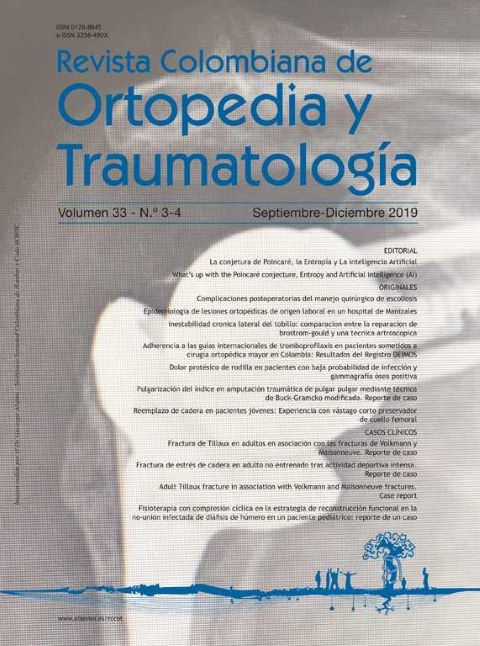Dolor protésico de rodilla en pacientes con baja probabilidad de infección y gammagrafía ósea positiva
DOI:
https://doi.org/10.1016/j.rccot.2020.02.005Palabras clave:
dolor peri protésico, prótesis de rodilla, infección, gammagrafía óseaResumen
Introducción: Los estudios de medicina nuclear han sido omitidos en el abordaje diagnóstico de prótesis dolorosa con sospecha de infección por heterogeneidad de la evidencia y costo efectividad. Existen pacientes con baja probabilidad de infección y gammagrafía ósea de tres fases positiva, el objetivo del estudio fue evaluar el desenlace diagnóstico y terapéutico de estos pacientes.
Materiales y métodos: Estudio observacional serie de casos. Se seleccionaron pacientes con antecedente de RTR, dolor protésico posoperatorio y/o rigidez, baja probabilidad de infección, PCR y VSG negativa y gammagrafía ósea de 3 fases positiva. Se evaluó dolor pre y posoperatorio, la escala de Oxford para rodilla y la necesidad de cirugía de revisión.
Resultados: Se estudiaron 20 pacientes, promedio de seguimiento 42,1 meses. No se identificó infección o aflojamiento al final del seguimiento en ninguno de los casos. Al 25% se realizó revisión protésica secundario a (artrofibrosis, síndrome patelofemoral y dolor), este subgrupo tuvo una puntuación promedio de Oxford de 23.8 y EVA 7 al final del seguimiento, en los pacientes no reintervenidos la puntuación promedio de Oxford y EVA fue de 29 y 5 respectivamente. En el 70% de los pacientes no se estableció la causa del dolor protésico.
Discusión: El diagnóstico etiológico de una prótesis fallida es un reto. En pacientes con baja probabilidad de infección y gammagrafía ósea de tres fases positiva la infección como factor casual es poco probable. Pocos estudios describen el resultado de la gammagrafía ósea en pacientes con baja probabilidad de infección.
Nivel de evidencia: IV estudio
Descargas
Referencias bibliográficas
Pradhan NR, Gambhir A, Porter ML. Survivorship analysis of 3234 primary knee arthroplasties implanted over a 26-year period a study of eight different implant designs. Knee. 2006 Jan;13:7-11. https://doi.org/10.1016/j.knee.2005.06.004
Baker PN, Van der Meulen JH, Lewsey J, Gregg PJ. The role of pain and function in determing patient satisfaction after total knee replacement: data from the National Joint Registry for England and Wales. J Bone Joint Surg [Br]. 2007;89-B:893-900. https://doi.org/10.1302/0301-620X.89B7.19091
Lombardi AV Jr, Berend KR, Adamas JB, Why knee remplacements fail in 2013 patient, surgeon, or implant. Bone Joint J. Nov;96-B (11 Supple A):101-4. https://doi.org/10.1302/0301-620X.96B11.34350
Mont MA, Waldman BJ, Hungerford DS. Evaluation of preoperative cultures before second stage reimplantation of a total knee prosthesis complicated by infection. A comparison group study. J Bone Joint Sur Am. 2000;82-A:1552-7. https://doi.org/10.2106/00004623-200011000-00006
Parvizi J, Gehrke T, Chen AF. Proceedings of the international Consensus Meeting on Periprosthetic Joint Infection. Bone Joint J. 2013 Nov;95-B:1450-2. https://doi.org/10.1302/0301-620X.95B11.33135
Williams F, McCall IW, Park WM, O'Connor BT, Morris V. Gallium67 scanning in the painful total hip replacement. Clin Radiol. 1981;32:431-9. https://doi.org/10.1016/S0009-9260(81)80292-9
Scher DM, Pak K, Lonner JH, Fenkel JE, Zukerman JD, Cesare DIPE. The predictive value of indium 111 leukocyte scan in the diagnosis of infected total hip, knee, or resection arthroplasties. J Arthroplasty. 2000;15:295-300. https://doi.org/10.1016/S0883-5403(00)90555-2
Palestro CJ, Sawyer AJ, Kim CK, Goldsmith SJ. Infected knee prosthesis; diagnosis with In 111 leukocyte Tc 99 m sulfur coloid and Tc 99 m MDP imaging. Radiology. 1991;179:8. https://doi.org/10.1148/radiology.179.3.2027967
Palestro CJ, Torres MA. Radionuclide imaging in Orthopaedic infection. Semin Nucl Med. 1997;XXVII:334-45. https://doi.org/10.1016/S0001-2998(97)80006-2
Parvizi J, Della Valle CJ. AAOS Clinical Practice Guideline: diagnosis and treatment of periprosthetic joint infections of the hip and knee. J Am Acad Orthop Surg. 2010 Dec;18:771-2. https://doi.org/10.5435/00124635-201012000-00007
Su EP, Della Valle AG. Stiffness after TKR: how to avoid repeat surgery. Orthopedics. 2010 Sep 7;33:658. https://doi.org/10.3928/01477447-20100722-48
Parvizi J, Zmistowski B, Berbari IEF, et al. New definition for periprosthetic joint infection form the world group of the musculoskeletal Infection Society. Clin Ortho Related Res. 2011;469:2992-4. https://doi.org/10.1007/s11999-011-2102-9
Martinez JP, Arango AS, Castro AM, Rondanelli AM. Validación de la versión en español de las escalas de Oxford para rodilla y cadera. Rev Colomb Ortop Traumatol. 2016;30: 61-6. https://doi.org/10.1016/j.rccot.2016.07.004
Pandey R, Quinn J, Joyner C, Murray DW, Triffitt JT, Athanasou NA. Arthroplasty implant biomaterial particle associated macrophages differentiate into lacunar resorbing cells. Ann Rheum Dis Jun. 1996;55:388-95. https://doi.org/10.1136/ard.55.6.388
Austin MS, Ghanem E, Joshi A, Lindsay A, Parvizi J. A simple, cost-effective screening protocol to rule out periprosthetic infection. J Arthroplasty. 2008 Jan;23:65-8. https://doi.org/10.1016/j.arth.2007.09.005
Smith SL, Wastie ML, Forster I. Radionuclide Bone Scinigaphy in the Detection of significant Complication after Total Knee Joint Replacement. Clinical Radiology. 2001;56:221-4. https://doi.org/10.1053/crad.2000.0620
Palestro CJ, Roumanas P, Swyer AJ, Kim CK, Goldsmith SJ. Diagnosis of musculoskeletal infection using combined In-111 labeled leukocyte and Tc-99m SC marrow imaging. Clin Nucl Med. 1992;17:269-73. https://doi.org/10.1097/00003072-199204000-00001
Segura AB, Munoz A, Brulles YR, Hernandez Hermoso JA, Diaz MC, Bajen Lazaro MT, Martin - Comin J. What is the role of bone Scintigraphy in the diagnosis of infected joint prostheses? Nucl Med Commun. 2004;25:527-32. https://doi.org/10.1097/00006231-200405000-00016
Palestro CJ. Nuclear medicine and the failed joint replacement: past, present, and future. World J Radiol. 2014 Jul 28;6:446-58, 19. https://doi.org/10.4329/wjr.v6.i7.446
Strobel K, Steurer - Dober I, Huellner MW, Veit-Haibach P, Allhayer B. Importance of SPECT/CT for knee and hip joint prostheses. Radiologe. 2012;52:629-37 (20). https://doi.org/10.1007/s00117-011-2270-3
Hofmann AA, Wyatt RWB, Daniels AU, et al. Bone scans after total knee arthroplasty in asymptomatic patients. Clin Orthop. 1990;251:183-8. https://doi.org/10.1097/00003086-199002000-00031
Rosenthall L, Lepanto L, Raymond F:. Radiophosphate uptake in asymptomatic knee arthroplasty. J Nucl Med. 1987;28:1546-9.
McDowell M, Park A, Gerlinger TL. The Painful Total Knee Arthroplasty Orthop Clin North Am. 2016 Apr;47:317-26. https://doi.org/10.1016/j.ocl.2015.09.008
Friedman RJ, Hirst P, Poss R, Kelley K, Sledge CB. Results of Revision total knee arthroplasty performed for aspetic loosening. Clin Orthop Relat Res. 1990 Jun;255:235-41. https://doi.org/10.1097/00003086-199006000-00031
Haiudukewych GJ, Jacofsky DJ, Pagnano MW, Trousdale RT. Functional results after revision of well-fixed components for stiffness after primarytotal knee arthroplasty. J Arthriplasty. 2005 Feb;20:133-8. https://doi.org/10.1016/j.arth.2004.09.057
Bourne RB, Chesworth BM, Davis AM, Mahomed NN, Charron KD. Patient satisfaction after total knee arthroplasty: who is satisfied and who is not? Clin Orthop Relat Res. 2010 Jan;468:57-63. https://doi.org/10.1007/s11999-009-1119-9
Hirschmann M. A Diagnostic Algorithm for patients with Painful Total Knee Replacement: What to do when. En: Hirschmann M, Becker R, editores. The Unhappy Total Knee Replacement A comprenhensive Review and Management Guide. Springer International Publishng Switzerland; 2015. p. 417-33. Capítulo 34. https://doi.org/10.1007/978-3-319-08099-4_40
Evaluation of painful Total Knee Arthroplasty; The Journal of Arthroplasty Vol 19 # No 4. Supple 1. June. 2004.28. https://doi.org/10.1016/j.arth.2004.02.008









